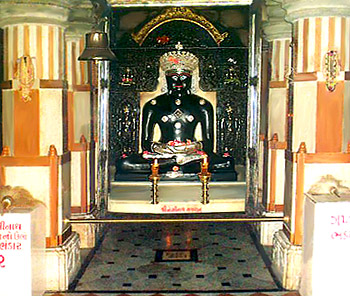 Neminatha was twenty-second Jain Tirthankar of the present age. He is also regarded as Arishtanemi. As per Jainism he had gained Siddha and had thus become a liberated soul. Neminatha also finds mention in Rig Veda Samhita alsong with Rishabha or Adinatha. Neminatha was born to King Samudra Vijaya and Queen Shivadevi at Souripur in the Harivamsha clan. His birth date is the 5th day of Shravana Shukla in the Indian calendar. The historical date of Lord Neminath was around 3100 B.C. He is also known as Arishtanemi. His birth date is the 5th day of Shravana Shukla in the Indian calendar.
Neminatha was twenty-second Jain Tirthankar of the present age. He is also regarded as Arishtanemi. As per Jainism he had gained Siddha and had thus become a liberated soul. Neminatha also finds mention in Rig Veda Samhita alsong with Rishabha or Adinatha. Neminatha was born to King Samudra Vijaya and Queen Shivadevi at Souripur in the Harivamsha clan. His birth date is the 5th day of Shravana Shukla in the Indian calendar. The historical date of Lord Neminath was around 3100 B.C. He is also known as Arishtanemi. His birth date is the 5th day of Shravana Shukla in the Indian calendar.
History of Lord Neminath
Lord Neminatha was the grandson of Andhakavrishni. Jainism dates back to the time of Parshvanatha or even before that. The Jain record mentions the names of twenty two Tirthankaras before him. Many Jains and some Hindus are said to be a cousin of Krishna, the lord of the Bhagavad Gita (Hindu scriptures).
According to both religions, Lord Krishna had settled his marriage with Rajamati. She was the daughter of Ugrasena. However as animals which were to be slaughtered for the marriage feast, Neminath opposed it and left the procession suddenly and renounced the world. Some writers of the Jain scriptures say that Tirthankara Neminatha was the master of Krishna.
In the Yajur Veda, Neminath has been regarded as one of the important Rishis or sages. He is described as one who is capable of crossing over the ocean of life and death, as the remover of violence, and one who is instrumental is sparing life from injury. The Yajurveda originated during 12th century BCE. Thus it specifies that Neminatha was known at this time and flourished even before.
The sage Ghora Angirasa of Chandogya Upanishads III is said to have imparted certain instructions of the spiritual sacrifice to Krishna, the son of Devaki.




















